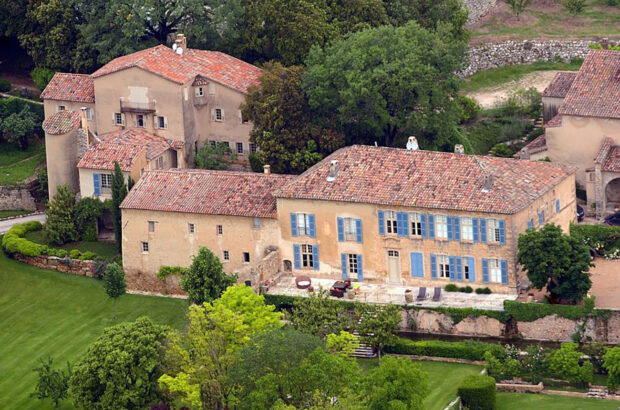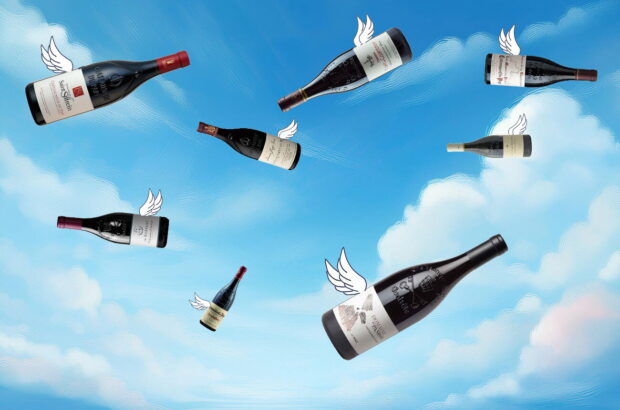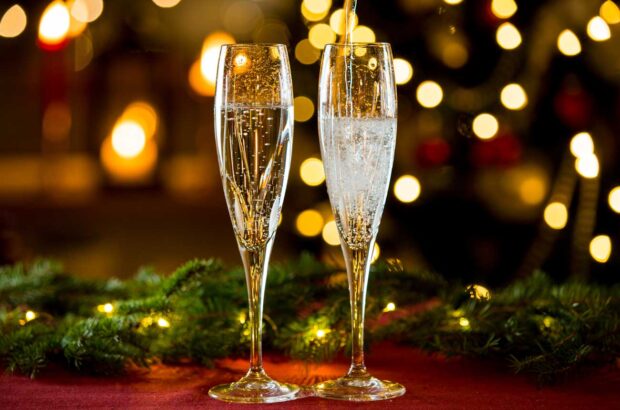Twenty years ago, he brought the New World to the UK’s living rooms. Now he’s returning to his roots – the Bordeaux region. In a deeply personal interview, Oz Clarke talks of his love affair with claret, and considers its ability to reach out to those same drinkers he first introduced to wine in the 1980s
We didn’t drink wine at home so I had no understanding of what wines from the Bordeaux region were. But I went to university at Oxford and wangled my way into the wine society. My first tasting was a wine from the Bordeaux region, and the last wine was a Léoville-Barton 1962. It was an unbelievable experience, and to this day, the Léoville-Barton 1962s of this world are the clarets I most covet. You don’t find that sort of claret so much these days: Léoville-, sometimes Langoa-Barton, Sociando-Mallet… Those wines were made in a cooler era, yet you had to pick early as the anti-rot sprays weren’t good enough. Sometimes you were lucky, sometimes not. 1962 was one of those lovely years, a bit like 2001. It was a rather forgotten vintage, but people drank it with an enormous amount of pleasure for about 20 years. Wine lovers should always look out for years like that. 2004 is a classic example, between 2003 and 2005. All Decanter readers ought to be buying 2001s and 2004s.
So off we’d go to tutorials, purely to persuade the tutors to open the cellars. We’d beg for wines from the Bordeaux region. Our English tutor would open Beychevelle 1961 or Lagrange 1961. We were positively aggrieved when he opened the Lagrange because it was bottled by Sandemans of Glasgow, whereas the Beychevelle was château-bottled. We’d lie on the floor drinking this claret quoting Wordsworth. I was at a beer college (Pembroke) so I’d sneak into other colleges like Christchurch or Trinity, which had big cellars, and I’d go to tutorials to get my hands on Montrose 1961, Lynch-Bages 1955, Langoa 1953, Haut-Bailly 1955. They’re my first images of wine, and only one wasn’t a Médoc.
The Left Bank was where I began. I built up a shorthand of the nuances of Left Bank flavours. Those unbelievable flavours stayed with me. When I was growing up, there were probably only half a dozen good Right Bank properties. I never saw them. St-Emilion was never sighted. Pomerol? I’d never heard of it. We’d see a lot of petits châteaux from all over, probably Côtes de Blaye or Bourg, but to be honest I don’t remember which, as they were almost without exception pretty awful – green and earthy. Iron filings and earth flavours of cheap Bordeaux, which you still find on the shelves today. Go to northern Europe, places like Germany, and you can get AC Bordeaux for E0.85, which is a bloody disgrace.
https://www.decanter.com/learn/left-right-bank-bordeaux-difference-436548/
The Right way to do it
Over the last 12 months I have, for the first time, spent enough time on the Right Bank to think to myself, ‘Bloody hell, what have I been missing?’ Jean-Luc Thunevin said to me: ‘I’ve been here for 15 years. Why didn’t you come here before?’ He was right. And I realised it was because I didn’t understand the garagistes. I was frightened of them. I resented the money they charged. And I didn’t understand what made them tick.
https://www.decanter.com/features/jean-luc-thunevin-decanter-interview-247351/
I still don’t appreciate all these wines, but looking at the Right Bank today, at the mid-market level where Bordeaux so desperately needs to make inroads, I’d rather drink the new wines from the Côtes than damp, weedy, sub-standard Médocs. There’s bargains to be had from the ‘lesser’ St-Emilons. Lalande de Pomerol? Yes please.
Admittedly, some of the other satellites taste muddy to my palate, but what makes the Right Bank so exciting in the Côtes de Castillon and the eastern côtes of St-Emilion is that people there can actually afford to do the work in the vineyards and the cellar – re-trellising, green harvesting, oak barrels, triage tables… To run a few hectares costs a few thousand man-hours. If you add it all up, you just can’t afford to do all these things and charge less than E6 or E7 a bottle. Now E6 or E7 is going to be £8.99 a bottle over here, and we can go to Chile or Argentina or Spain for that. At £8.99, there’ll be far more good stuff from Chile than Bordeaux.
There are a few star buys around £8 from the Bordeaux region, and most of them come from the Côtes. Take Seigneurs d’Aiguilhe at £7.99, the second wine of Château d’Aiguilhe from Côtes de Castillon. It’s a smasher, an unbelievably good wine at that price. There aren’t many wines from the Bordeaux region that good at that price. But when people like Stephan von Neipperg [of Canon-La-Gaffelière and Château d’Aiguilhe], [Château Pavie’s] Gérard Perse, the Bécots of Beau-Séjour Bécot who start investing and charging a bit more for their wine, it encourages others to think, ‘Our soil is the same’. Von Neipperg has been the leader. Thunevin is the same at Valandraud, even though this is in St-Emilion, and his wines are more expensive. He’s right at the end of St-Emilion, just half a mile from the end of the appellation. But he’s on less than a metre of clay, and then solid limestone, and it’s pretty much the same as Canon, just a touch harder. Then, a mile on, you’re in Castillon. It’s the same basic conditions.
But it’s the social conditions that are key. The likes of Le Pin’s Thienponts going into Côtes de Francs are not going to say: ‘Oh well, this terroir’s a bit crappy, we won’t bother.’ They’ll say: ‘Well, this is how we do it at Le Pin, or Cheval Blanc, or Beau-Séjour Bécot, so this is what we’ll do here.’ Then they come out with fantastic wines, and people say: ‘Bloody Hell, these wines, are, in all but name, premier cru classé St-Emilion. Which should encourage more people to look at the Côtes. But it costs money, so you need to charge around E20 a bottle to get a good oenologist and do it properly.
It’s a movement, a tide, and Côtes de Castillon has caught that tide. Côtes de Bourg and Blaye haven’t, although Côtes de Blaye is the most improved area I went to in all of the Bordeaux region. It used to be such a jammy, dull, flat-flavoured wine, and now there are dozens of wines coming out of Blaye, gentle, round, mellow, St-Emilion types, half the price or less. Often it’s down to the younger generation coming in at existing châteaux, sons and daughters taking over. Sometimes it’s people coming down from Paris who can’t afford to buy in Pomerol, or there’s nothing available, or it’s a choice between 4ha and an ugly Pomerol château, or 24ha in the Côtes, and a beautiful château. They come from business backgrounds, and know how to sell wine. Whereas some of the kids in the Bordeaux region come out of college knowing how to make wine, oenology and viticulture, but not marketing. In Blaye and Bourg it’s different, and there are some seriously good prestige cuvées coming out of here, with some serious St-Emilion-type flavours.
I’m optimistic for the Right Bank. Côtes de Castillon’s potential hasn’t been exploited. The land is relatively cheap so the wine can be as well. It’s perfectly obvious the conditions there are good, you just need to find people to invest. The trouble is, lower down the market at £5.99, the wines don’t work. There are some pleasant wines from Côtes de Bourg, Blaye, Premières Côtes, but they’re light, mild, gentle. As soon as they try to get any more serious, well they’re on loam and clay soils and it’s very difficult with Cabernet. Ripping out all the Cabernet and planting Merlot would be easier, but you can’t – they’ve got all this Cabernet there, and at the end of the day they’re farmers. But you’ll never ripen Cabernet there. Those vineyards should be converted to either white or rosé production,. That’s what they should all be doing in Entre-Deux-Mers – making rosés and whites. They shouldn’t even be attempting to make reds. Even the really good people, like Tour de Mirambeau, which is a top producer of whites, struggle to get their reds right.
The white way to do it
Half of the Bordeaux regions wines used to be white, and half of Bordeaux should be white again. The trouble is, there’s no market for it. And yet it has exactly what the market wants – light, tangy, snappy, clean, young whites. Bordeaux does it better than the Loire. It comes down to marketing and politics. And effort. It needs someone to take the lead and create a big brand. Dourthe makes the effort, and is getting better every year, but that’s about it. With all that loam and clay in the Entre-Deux-Mers, you can’t ripen your reds properly on that, particularly in the style that the modern world wants from a red wine, which is a relatively ripe, full wine with dark colour. Now that’s the most difficult thing to get in much of Bordeaux. You can’t in the Médoc or the St-Emilion plateau. But in most places, to try and get a dark colour, and a ripe fruit flavour that isn’t over-extracted and raisined, it’s not going to come – the terroir isn’t good enough.
This bloody terroir thing. When you walk round the Bordeaux region for a few months, it begins to make sense, and you start to realise that there really are better and worse bits. And most bits of Bordeaux are worse. Look at Entre-Deux-Mers – Châteaux de Reignac or Pey-La-Tour are exceptions: they’re at the limit of the grape-growing area, but they’ve both got patches of special land, and both make excellent wine. But it comes down to investment, and they can afford to invest – M Vatelot, who owns Reignac, is a rich man and Dourthe owns Pey-La-Tour so they can make it a little niche brand of their own.
When it comes to brands, the reds have got it really difficult. The appellation should ease up and allow riper stuff to be brought in from somewhere else. Even with global warming, you’re still on those clay soils, and it’s very difficult to get a fruit expression. The red wines that express fruit in Bordeaux are very much in the minority. What they can do is get texture right. That appetising, savoury style is one which you need to already like wine a bit in order to appreciate. It’s one of Bordeaux’s major problems. They make it difficult to make crowd-pleasers. That only happens when the sun shines relentlessly and you can irrigate as much as you want and make things in an industrial way, with yeasts and a vision of flavour based on fruit and residual sugar and oak chips or whatever. Instead of that, you’ve got a frightened, nervous, half-bankrupt peasant smallholder society, desperately worried in the middle of September that the rains are going to come:
‘We’ve got to pick.’ they’ll say.
‘Don’t pick.’
‘We’ve got to pick, the rains are coming.’
‘Don’t pick – did you use that spray I told you about?’
Now they probably didn’t spray, and they know they didn’t spray because they were trying to save a few bob, so they know if the rains come their grapes will rot, and they won’t sell their crop. At the bottom end, there’s not much difference in the price of a tonneau of grapes now to 10 years ago, because they’ve lost their market.
The discounters have a real responsibility. As they’ve pushed the price further and further down, there’s less and less investment possible in the bottom-end vineyards or in the coops trying to sell this wine, and you end up with people selling wine for less than a euro a bottle. All you can end up with is the wine getting worse and worse. And it’s now infecting the French market. The French always used to have enormous respect for the name Bordeaux. Every year, half the basic Bordeaux Supérieur or petit château wine was sold in France. People bought it for their Sunday lunch. Wine has become so cheap now – the advertising you see on the side of the road is all about price, price, price, and people can’t put any decent grog out there any more because there’s always someone who will sell it cheaper than someone else. So the big discounters wait for someone to come and say, ‘I’ve got it cheaper than my neighbour.’ So they put the cheaper stuff in, and it’s worse, and people have lost respect for Bordeaux at that bottom end. The only way to get it back is to take a million or two hectolitres out of the system completely, and get back to the petits châteaux system.
In the 1980s, when I was trying to democratise the world of wine via TV, Bordeaux had nothing to offer. There were no affordable wines, the château system was not well explained. But the modern zeitgeist is about people taking care of and cherishing the land, in vegetables and fruit, and cattle. Bordeaux’s got all that, but hasn’t found a way of explaining it.
If I was doing it all again now, with a nation of wine lovers to deal with, who are more confident and inquisitive than before, you’d be dealing with people who want to make the step up from New World and are ready to spend £10 on a bottle. But for £10 you can’t give them Peyrabon, Pibron, Batailley, Cambon La Pelouse, so you have to go to the Right Bank, and Blaye, which has the best potential, up towards Cognac, where there’s an enormous number of pleasant, soft, mild reds, all mainly Merlot.
Haut-Gironde is one of the best coops in Bordeaux, right up in north Blaye. It’s a top place for whites. The grapes for Dourthe No 1 and Sirius come from up there. But the area means nothing to the consumer, with all those long château names. The 1980s generation who came into wine through the New World are used to short names, with Cabernet, Merlot or Shiraz. Old-fashioned labels with unpronounceable names are no use, no matter how attractive the modern style of dry, soft wine in the bottle. You need someone to go in and take control of the contracts and growers, pay an annual fee, and make a big brand. A Cabernet brand. But making a big-volume brand in a marginal climate is tough. Big brands don’t come from marginal climates, they come from the Central Valley in California. Or the irrigated New South Wales.
The trouble is, the Bordeaux region is never been one to say ‘You’re gonna love this’. Bordeaux says: ‘If you work hard, you might come to appreciate this.’ Luckily, I stuck with it.
Oz Clarke’s Bordeaux is published by Websters (£18.99) on 2 November.







